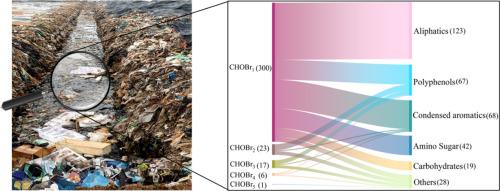中国渗滤液中溴化有机化合物的分布及其分子变异
IF 12.4
1区 环境科学与生态学
Q1 ENGINEERING, ENVIRONMENTAL
引用次数: 0
摘要
目前,中国是世界上最大的溴化阻燃剂(BFRs)生产国和消费国。大量的生物燃料反应堆从垃圾填埋场和焚化场的废物中冲洗出来,成为受污染的渗滤液的一部分。然而,在中国各地的渗滤液中,溴化有机化合物(BOCs)的存在和分子变化在很大程度上仍未被探索。在收集了中国87个垃圾填埋场或焚烧场的渗滤液样本后,采用傅立叶变换离子回旋共振质谱法结合中性模型对BOCs进行了研究。结果表明,约80.5%的渗滤液样品含有不超过30个溴化有机分子(BOMs),全国共检测到347个溴化有机分子,其中单溴化有机分子占86.5%。这些已确定的bom包括脂肪族(123种)、多酚类(67种)、缩合芳香族(68种)、氨基糖(42种)和碳水化合物(19种)。它们具有5-12个碳原子,高度不饱和,芳香性强,不易生物降解。显然,垃圾渗滤液中BOCs的分子变化比焚烧渗滤液更具随机性。本研究在全国范围内对渗滤液中BOCs进行了非定向调查,为渗滤液中BOCs的风险评估和污染控制提供科学依据。本文章由计算机程序翻译,如有差异,请以英文原文为准。

Brominated organic compounds in leachate across China: Occurrence and molecular variations
At present, China is the world’s largest producer and consumer of brominated flame retardants (BFRs). Substantial quantities of BFRs are washed out of waste from landfill and incineration sites, and are become part of the contaminated leachate. However, the occurrence and molecular variations of brominated organic compounds (BOCs) in leachate across China remains largely unexplored. Upon collecting leachate samples from 87 landfill or incineration sites throughout China, the BOCs are explored using Fourier transform ion cyclotron resonance mass spectrometry coupled with the neutral model. The results show that ∼80.5% of the leachate samples contain no more than 30 brominated organic molecules (BOMs), and 347 BOMs are detected across China, with monobrominated organic molecules constituting 86.5%. These identified BOMs include aliphatics (123 types), polyphenols (67 types), condensed aromatics (68 types), amino sugar (42 types), and carbohydrates (19 types). They possess 5–12 carbon atoms and are highly unsaturated, strongly aromaticit, and less biodegradable. Evidently, the molecular variations of BOCs are more stochastic in landfill leachate compared with those in incineration leachate. This study presents a nontargeted survey of BOCs in leachate at a national scale in China, providing a scientific basis for risk assessment and pollution control of BOCs in leachate.
求助全文
通过发布文献求助,成功后即可免费获取论文全文。
去求助
来源期刊

Water Research
环境科学-工程:环境
CiteScore
20.80
自引率
9.40%
发文量
1307
审稿时长
38 days
期刊介绍:
Water Research, along with its open access companion journal Water Research X, serves as a platform for publishing original research papers covering various aspects of the science and technology related to the anthropogenic water cycle, water quality, and its management worldwide. The audience targeted by the journal comprises biologists, chemical engineers, chemists, civil engineers, environmental engineers, limnologists, and microbiologists. The scope of the journal include:
•Treatment processes for water and wastewaters (municipal, agricultural, industrial, and on-site treatment), including resource recovery and residuals management;
•Urban hydrology including sewer systems, stormwater management, and green infrastructure;
•Drinking water treatment and distribution;
•Potable and non-potable water reuse;
•Sanitation, public health, and risk assessment;
•Anaerobic digestion, solid and hazardous waste management, including source characterization and the effects and control of leachates and gaseous emissions;
•Contaminants (chemical, microbial, anthropogenic particles such as nanoparticles or microplastics) and related water quality sensing, monitoring, fate, and assessment;
•Anthropogenic impacts on inland, tidal, coastal and urban waters, focusing on surface and ground waters, and point and non-point sources of pollution;
•Environmental restoration, linked to surface water, groundwater and groundwater remediation;
•Analysis of the interfaces between sediments and water, and between water and atmosphere, focusing specifically on anthropogenic impacts;
•Mathematical modelling, systems analysis, machine learning, and beneficial use of big data related to the anthropogenic water cycle;
•Socio-economic, policy, and regulations studies.
 求助内容:
求助内容: 应助结果提醒方式:
应助结果提醒方式:


